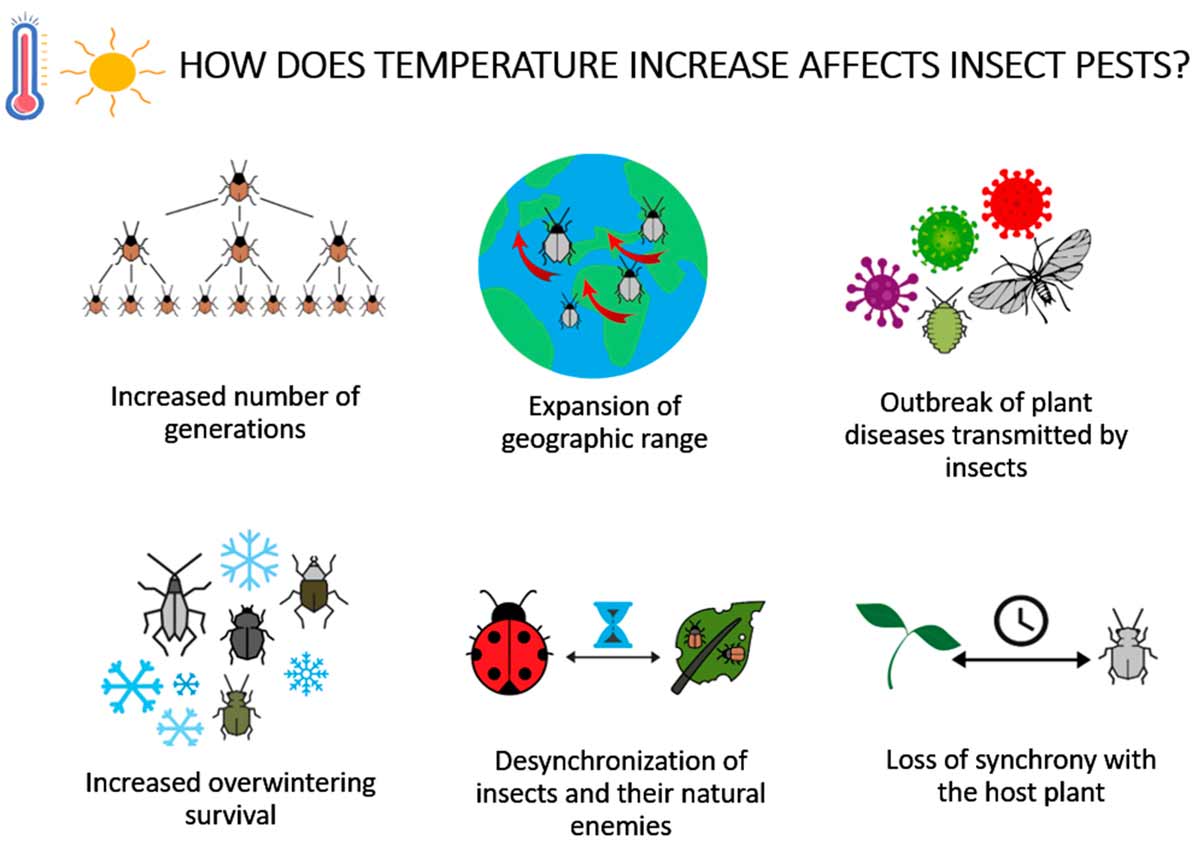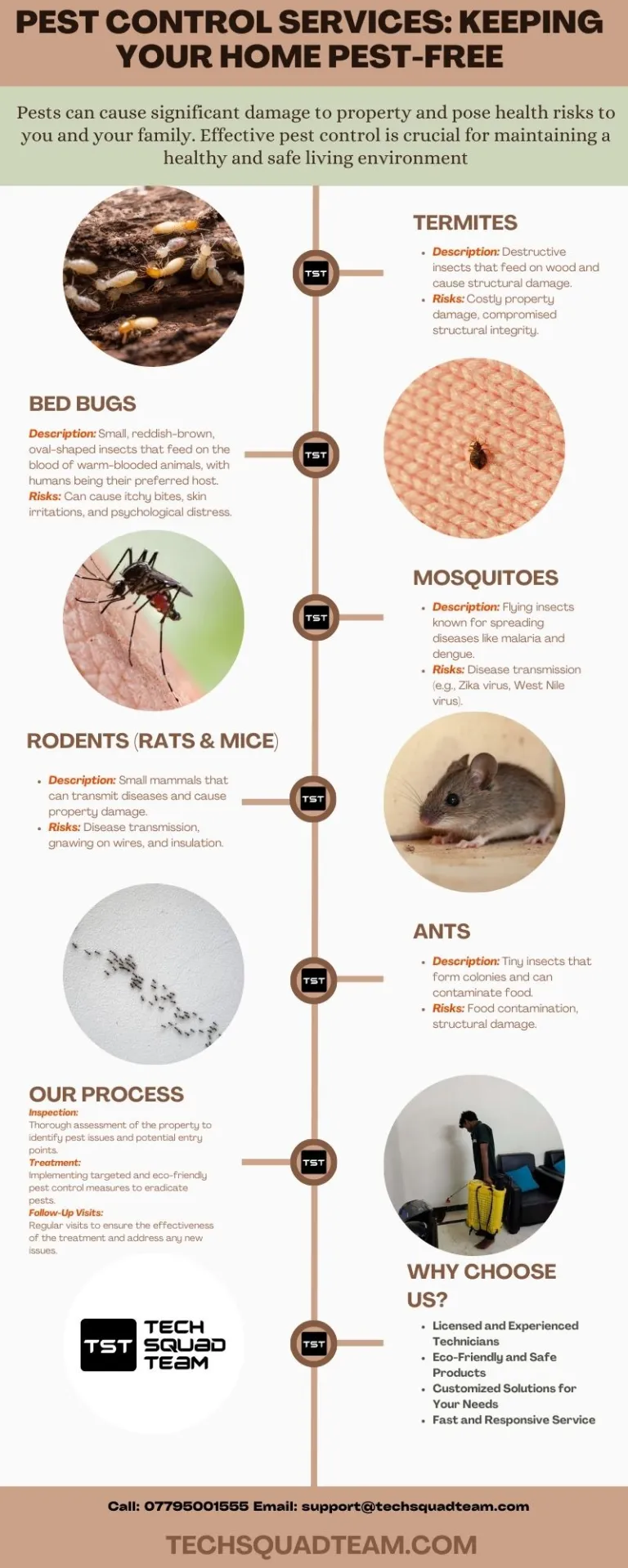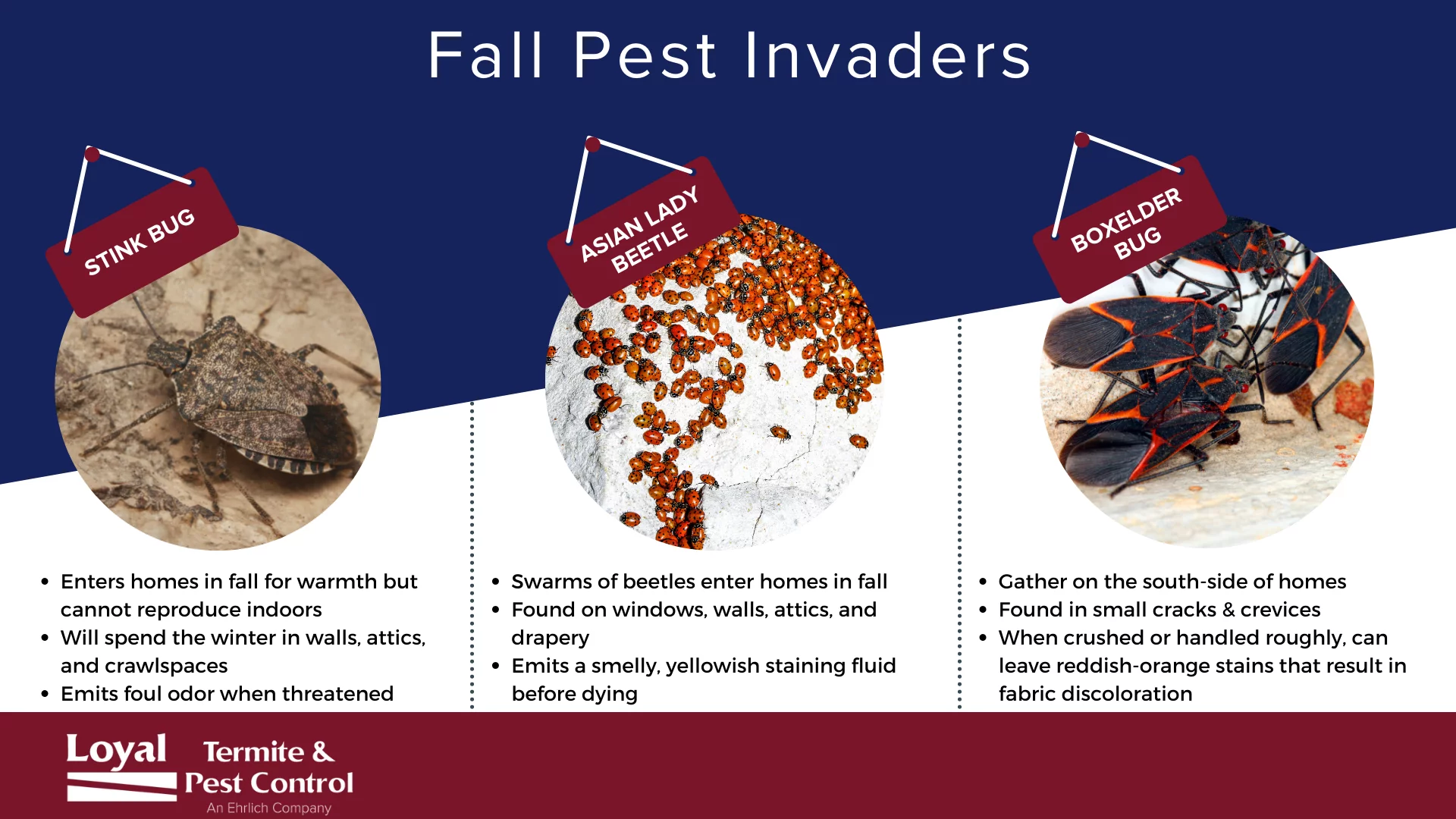Understanding Pest Problems: Common Invaders and Why They Threaten Your Home
Introduction: Why Knowing Your Enemy Is the First Step to a Pest-Free Home
Imagine coming home after a long day and discovering unwanted guests—tiny invaders scuttling across your kitchen counter, or worse, signs of rodents nesting behind your walls. Pest problems aren’t just a nuisance; they threaten the health, comfort, and safety of your home and family. To fight pests effectively, you need to understand exactly what you’re dealing with: who these pests are, why they invade, and what risks they pose.
In this part, we’ll take a deep dive into the most common household pests, explore why they choose our homes as their playground, and uncover how their presence can affect your daily life. Armed with this knowledge, you’ll be ready to spot early signs of infestation and take action before the problem escalates.
1. The Usual Suspects: Common Household Pests
When it comes to pests, not all are created equal. Different invaders bring unique challenges. Here are the most frequent culprits causing headaches for homeowners:
a. Insects
-
Cockroaches: These resilient insects thrive in warm, humid environments like kitchens and bathrooms. They spread bacteria and allergens, aggravating asthma and allergies.
-
Ants: Various species invade homes searching for food and water. Carpenter ants can even damage wooden structures.
-
Termites: Often called “silent destroyers,” termites eat through wood unnoticed until serious structural damage occurs.
-
Bed Bugs: Nighttime bloodsuckers that cause itchy, irritating bites and can be notoriously difficult to eliminate.
-
Mosquitoes: Besides the itchy bites, mosquitoes are vectors for serious diseases like West Nile virus and Zika.
-
Flies: House flies and fruit flies contaminate food and surfaces with bacteria.
b. Rodents
-
Rats and Mice: These furry intruders chew wires, contaminate food, and spread diseases such as Hantavirus and salmonella. They reproduce quickly, making early detection crucial.
c. Other Invaders
-
Spiders: Most spiders are harmless and even beneficial, but some species (like black widows or brown recluses) pose health risks.
-
Wasps and Bees: While important for the ecosystem, their nests near homes can be dangerous due to stings.

Infographic : Pest Control Services: Keeping Your Home Pest
2. Why Do Pests Invade Homes?
Pests don’t randomly appear. Understanding why they choose your home is key to prevention and control.
Food Sources
Crumbs, open garbage, pet food, and unsealed pantry items attract pests constantly looking for an easy meal.
Shelter and Warmth
Homes provide shelter from predators and harsh weather. Pests seek warm, moist areas for nesting — basements, attics, wall voids, and plumbing areas are common hideouts.
Water Availability
Leaks, standing water, and damp environments attract moisture-loving pests like cockroaches, mosquitoes, and termites.
Seasonal Patterns
Many pests invade in certain seasons: rodents seek warmth in winter; mosquitoes flourish in summer. Recognizing these patterns helps anticipate infestations.
3. The Hidden Dangers: Health and Property Risks
Pests aren’t just gross—they carry real dangers:
Health Risks
-
Allergies and asthma triggers from cockroach droppings and dust mite debris
-
Disease transmission from rodents and mosquitoes
-
Skin infections and irritation from bed bug and flea bites
Property Damage
-
Structural weakening from termites and carpenter ants
-
Electrical fires from rodents chewing wiring
-
Food contamination and waste
4. Early Warning Signs of Pest Infestation
Detecting pests early can save thousands in damage and health costs. Watch for:
-
Droppings (small black pellets or specks)
-
Gnaw marks on food packaging or wood
-
Unusual odors (musty or oily smells)
-
Tracks or smudge marks along walls and baseboards
-
Shed skins or eggshells
-
Nocturnal sounds like scratching or scampering
-
Visible insects or nests
5. Summary Table: Common Pests, Signs, and Risks
| Pest | Common Signs | Risks | Preferred Habitat |
|---|---|---|---|
| Cockroaches | Droppings, egg cases, musty odor | Allergies, asthma, bacteria | Warm, humid kitchens |
| Ants | Trails, small holes, wood damage | Food contamination, wood damage | Kitchens, wooden structures |
| Termites | Mud tubes, hollow wood, discarded wings | Structural damage | Wood, foundations |
| Bed Bugs | Bites, blood spots on sheets | Skin irritation, sleep loss | Mattresses, furniture |
| Mosquitoes | Bites, larvae in standing water | Disease vectors (West Nile) | Stagnant water |
| Rats & Mice | Droppings, gnaw marks, nests | Disease transmission, wiring damage | Walls, attics, basements |
Trusted Resources and Further Reading
This sets the foundation for understanding your enemy in the pest control battle. Next up: diving deep into prevention and treatment strategies.
Effective Pest Control Strategies: From Prevention to Safe Treatment Options
Introduction: Taking Back Control — How Smart Strategies Keep Pests Away
Once you know the enemy, the next step is learning how to fight it — effectively and safely. Pest control isn’t just about spraying chemicals blindly or calling an exterminator at the first sight of a bug. The best results come from combining prevention, monitoring, and targeted treatment methods.
In this part, we’ll explore the full arsenal of pest control options available today. From simple home maintenance steps to advanced professional techniques, you’ll discover how to keep your home pest-free without compromising your family’s health or the environment.
1. Prevention: The Most Powerful Pest Control Tool
The old saying “an ounce of prevention is worth a pound of cure” couldn’t be truer in pest control. Preventive measures create barriers pests can’t cross and remove their motivations to invade.
a. Seal Entry Points
Pests squeeze through cracks smaller than a dime. Regularly inspect and seal:
-
Gaps around windows and doors
-
Cracks in foundations and walls
-
Open vents and chimneys
-
Utility line entries
Use weather-stripping, caulk, steel wool, and door sweeps. For rodents, materials like copper mesh work well.
b. Maintain Cleanliness
Keep kitchens, pantries, and dining areas free of crumbs and food residue. Clean spills promptly and store food in airtight containers. Regularly empty garbage bins and clean pet feeding areas.
c. Reduce Moisture
Fix leaks in plumbing and roofs immediately. Use dehumidifiers in damp basements and ensure proper drainage away from your home.
d. Manage Landscaping
Trim tree branches and shrubs away from the house, remove leaf litter, and avoid stacking firewood next to walls, which provide pest harborage.
e. Proper Waste Management
Ensure outdoor trash bins are sealed and cleaned frequently to prevent attracting pests.
2. Treatment Options: Chemical, Natural, and Integrated Approaches
When prevention isn’t enough, treatment becomes necessary. It’s essential to choose the safest, most effective options.
a. Chemical Treatments
Conventional Pesticides
-
Insecticides: Target specific insect pests; available as sprays, baits, or dusts.
-
Rodenticides: Poison baits for rats and mice.
Pros: Fast-acting, widely available, effective.
Cons: Potential toxicity to humans, pets, and wildlife; environmental concerns.
Safety Tips for Chemical Use
-
Follow label instructions exactly.
-
Keep chemicals out of children’s and pets’ reach.
-
Use protective gear.
-
Avoid over-application to reduce resistance.
b. Natural and Organic Treatments
Essential Oils and Botanicals
Neem oil, peppermint, eucalyptus, and citrus oils repel many pests. Diatomaceous earth (a natural powder) kills insects by damaging their exoskeletons.
Biological Controls
Using natural predators such as ladybugs for aphids or nematodes for soil pests.
Pros: Environmentally friendly, low toxicity.
Cons: May require repeated applications, slower action.
c. Integrated Pest Management (IPM): The Gold Standard
IPM combines monitoring, prevention, and targeted treatments to manage pests sustainably.
Key Principles:
-
Identify the pest accurately.
-
Monitor pest populations regularly.
-
Use cultural, mechanical, and biological controls first.
-
Apply chemicals only when necessary, in a targeted manner.
IPM reduces pesticide use, lowers costs, and minimizes risks to humans and the environment.
3. DIY Pest Control vs. Professional Services
Knowing when to tackle pests yourself and when to call the pros is crucial.
a. DIY Control
Suitable for minor infestations like ants or flies. Requires:
-
Identification of the pest
-
Proper products and tools
-
Safety precautions
-
Regular monitoring
DIY methods save money and give immediate control but may fail with large or persistent infestations.
b. Professional Exterminators
Advantages:
-
Expertise in pest identification and biology
-
Access to professional-grade treatments
-
Comprehensive inspection and customized plans
-
Long-term prevention advice
Choose licensed, reputable pest control companies with positive reviews and guarantees.
4. Safe Handling and Environmental Considerations
Using pest control responsibly protects your family and planet.
-
Opt for targeted treatments to avoid harming beneficial insects like bees.
-
Dispose of leftover chemicals according to local regulations.
-
Avoid spraying near water sources.
-
Consider non-chemical methods first, especially if you have children or pets.
5. Table: Common Pest Treatments and Suitability
| Pest | DIY Treatment Options | Professional Treatment Options | Notes |
|---|---|---|---|
| Cockroaches | Gel baits, boric acid, traps | Insecticide sprays, dusts | Focus on sanitation |
| Ants | Baits, essential oils, sealing entry points | Sprays, barrier treatments | Identify species for best control |
| Termites | Limited (bait stations) | Fumigation, liquid termiticides | Requires professional expertise |
| Bed Bugs | Heat treatment, mattress covers | Heat/steam treatments, chemicals | Professional help recommended |
| Rodents | Snap traps, glue boards | Rodenticides, exclusion services | Safety precautions crucial |
| Mosquitoes | Remove standing water, repellents | Larvicides, fogging | Focus on breeding site control |
6. Case Study: Successful IPM Implementation in a Suburban Home
A suburban family struggled with recurring cockroach and rodent problems. After multiple DIY attempts failed, they hired an IPM-certified pest control company. The experts:
-
Conducted a thorough inspection
-
Sealed all entry points and repaired leaks
-
Educated the family on sanitation and food storage
-
Used bait stations and targeted insecticides only where needed
-
Set up monitoring traps for ongoing control
Within two months, the infestation was under control, with a lasting pest-free environment.
Trusted Resources
Maintaining a Pest-Free Home: Long-Term Tips, Tools, and Expert Advice
Introduction: The Ongoing Battle — How Consistency Wins the Pest Control War
Pest control isn’t a one-time fix; it’s an ongoing commitment. Even after you’ve cleared an infestation, pests can return if vigilance wanes. The key to long-term success is establishing routines, using modern tools, and staying informed.
In this final part, we’ll share tried-and-true maintenance habits, highlight cutting-edge pest control technologies, and bring in expert voices to help you keep your home pest-free — for good.
1. Routine Maintenance: Your First Line of Defense
Consistency in upkeep prevents pests from gaining a foothold again.
a. Regular Home Inspections
-
Check for new cracks or gaps every 3–6 months
-
Monitor usual pest hotspots: kitchens, basements, attics
-
Inspect plumbing and drain areas for leaks or standing water
b. Sanitation Habits
-
Clean food prep areas daily
-
Don’t leave pet food out overnight
-
Take out garbage regularly, clean bins
c. Yard and Landscaping Care
-
Trim bushes and trees away from structures
-
Remove leaf litter and debris
-
Keep firewood elevated and stored away from the house
d. Seasonal Preparations
-
Seal entry points before winter to block rodents
-
Eliminate standing water in spring to reduce mosquitoes
-
Maintain gutters and drainage to prevent moisture buildup
2. Modern Tools and Technologies in Pest Control
Technology is advancing pest control in exciting ways.
a. Smart Monitoring Systems
-
Electronic traps that notify your phone when triggered
-
Sensors that detect motion or pest activity in walls or crawl spaces
b. Eco-Friendly Innovations
-
Ultra-low toxicity baits and gels
-
Heat treatments for bed bugs that avoid chemicals
-
Biological agents like parasitic wasps to control pests naturally
c. Automated Sprayers and Foggers
-
Timed devices for outdoor mosquito control
-
Targeted indoor misting systems reducing chemical use

Infographic : Pest Control Services: Keeping Your Home Pest
3. Seasonal Checklist for Year-Round Pest Management
| Season | Key Actions | Target Pests |
|---|---|---|
| Spring | Clean gutters, remove standing water | Mosquitoes, ants |
| Summer | Repair screens, inspect for wasp nests | Wasps, flies, cockroaches |
| Fall | Seal cracks, store firewood properly | Rodents, spiders |
| Winter | Check attic and basement for rodent activity | Rodents, overwintering insects |
4. Expert Advice: Interviews and Pro Tips
Interview with Jane Roberts, Certified Pest Control Specialist
“Regular monitoring and combining prevention with smart treatment is the most effective strategy. Homeowners should not hesitate to consult professionals early — it saves money and stress.”
Pro Tips
-
Use sticky traps for early detection
-
Rotate treatment methods annually to prevent pest resistance
-
Maintain a pest diary to track sightings and treatments
5. Troubleshooting Common Issues
| Problem | Possible Cause | Suggested Solution |
|---|---|---|
| Persistent ant trails | Multiple entry points or food sources | Re-inspect and reseal; deep clean |
| Recurring rodent sightings | Nest inside walls or attic | Professional exclusion and trapping |
| Bed bugs after treatment | Missed eggs or reinfestation | Professional heat treatment |
| Cockroach comeback | Hidden water sources | Fix leaks, improve ventilation |
6. FAQs: Your Questions Answered
Q1: How often should I have professional pest inspections?
At least once a year, or more frequently if you live in a high-risk area.
Q2: Are natural repellents effective long-term?
They help reduce pest activity but often need to be combined with other methods for full control.
Q3: Can pest control chemicals harm my pets?
Yes, always inform your pest control provider about pets and follow safety instructions carefully.
Q4: What’s the best way to prevent termite damage?
Regular inspections, removing wood debris near the home, and treating soil barriers.
7. Resources and Further Reading
8. Conclusion: Empowered to Win the War Against Pests
Pest control is a marathon, not a sprint. By understanding your pests, using effective prevention and treatment strategies, and maintaining vigilance, you can protect your home and family from unwanted invaders. With modern tools and expert guidance, you’re well-equipped to keep your sanctuary safe — pest-free, healthy, and comfortable.
YouTube Video Recommendation for Further Learning
Here’s an excellent, detailed video by a top pest control expert that complements this guide:


